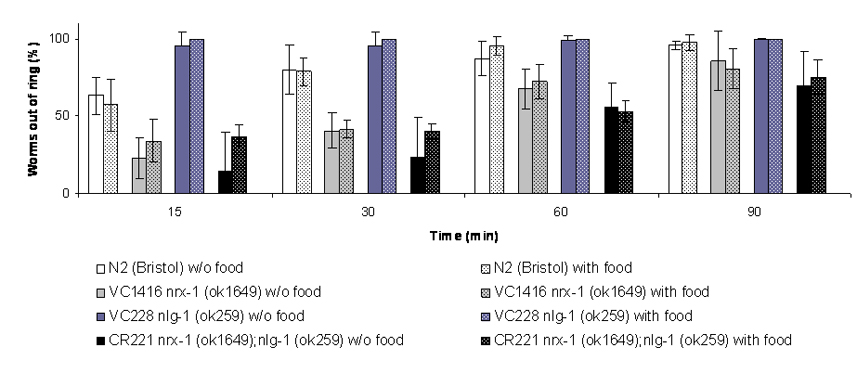C. elegans dwells in humus where it feeds on microorganisms. Movement in the worm is the result of environmental and internal signals creating stimulatory and inhibitory output from sensory neurons. Mutants deficient in neurexin (nrx-1) and/or neuroligin (nlg-1) genes exhibit impairment in excitatory and inhibitory neuronal synapses. It has been shown that nlg-1 deficient mutants are defective in detecting osmotic strength (Calahorro et al., 2009) and other sensory behavior (Hunter et al., 2010). Here we illustrate a simple experiment that allows quantifying the roaming behaviour phenotype in neuroligin and neurexin defective mutants of C. elegans. The results of a representative experiment are shown in Figure 1.
The experiment was carried out as follow: 1) Worms were grown synchronously at 20°C on NGM agar plates to L4 stage. Animals were washed three times with CTX buffer (5 mM K2HPO4, KH2PO4 buffer pH 6.6; 1 mM CaCl2; 1 mM MgSO4). 2) One central circle, 1 cm of diameter, was drawn on the back of two types of assay plates: NGM plates without OP50 bacteria, and NGM plates seeding with 100 µl of OP50 outlining a ring (0.5 cm of thickness) in the perimeter, maintaining free of bacteria the centre of the plate. The plates were incubated for 24 hours at 37°C before used. 3) Around 20-30 washed worms were pipetted in the middle of the agar, coinciding with the centre of the circle drawn on the back of the plate. The excess of liquid was gently removed with a small sterile filter paper. 4) The animals, out of the ring, were counted every 15 minutes.
Figures

References
Calahorro C, Alejandre E, Ruiz-Rubio M. (2009). Osmotic avoidance in Caenorhabditis elegans: synaptic function of two genes, orthologues of human NRXN1 and NLGN1, as candidates for autism. J. Vis. Exp. 34, pii: 1616. 
Hunter JW, Mullen GP, McManus JR, Heatherly JM, Duke A, Rand JB. (2010). Neuroligin deficient mutants of C. elegans have sensory processing deficits and are hypersensitive to oxidative stress and mercury toxicity. Dis. Model Mech. 3, 366-76. 




